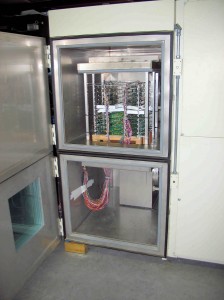 Thermal shock testing also called temperature shock testing or temperature cycling exposes products to alternating low and high air temperatures to accelerate failures caused by repeated temperature variations during normal use conditions. The transition between temperature extremes occurs very rapidly during thermal shock testing, greater than 15 °C per minute. Alternatively, temperature cycle testing uses slower rates of change between high and low temperatures. The failure acceleration rate for thermal shock testing is determined by the Coffin-Manson equation as previously discussed in DES’s blog article Temperature Cycling Testing: Coffin-Manson Equation.
Thermal shock testing also called temperature shock testing or temperature cycling exposes products to alternating low and high air temperatures to accelerate failures caused by repeated temperature variations during normal use conditions. The transition between temperature extremes occurs very rapidly during thermal shock testing, greater than 15 °C per minute. Alternatively, temperature cycle testing uses slower rates of change between high and low temperatures. The failure acceleration rate for thermal shock testing is determined by the Coffin-Manson equation as previously discussed in DES’s blog article Temperature Cycling Testing: Coffin-Manson Equation.
Equipment with single or multiple chambers may be used to perform thermal shock testing. When using single chamber thermal shock equipment, the products or samples remain in one chamber and the chamber air temperature is rapidly cooled and heated. This usually results in a slower rate of change in the product response temperature as the entire chamber must be cooled down and heated up. However larger products can be tested in single compartment chambers. Some equipment uses separate hot and cold chambers with an elevator mechanism that transports the products between two or more chambers. This results in a more rapid rate of change in the air temperature. However, there is a limit to the size and weight than can be put in a chamber with an elevator mechanism. DES has both types of chambers for thermal shock testing.
Continue reading Thermal Shock Testing – Temperature Cycling →